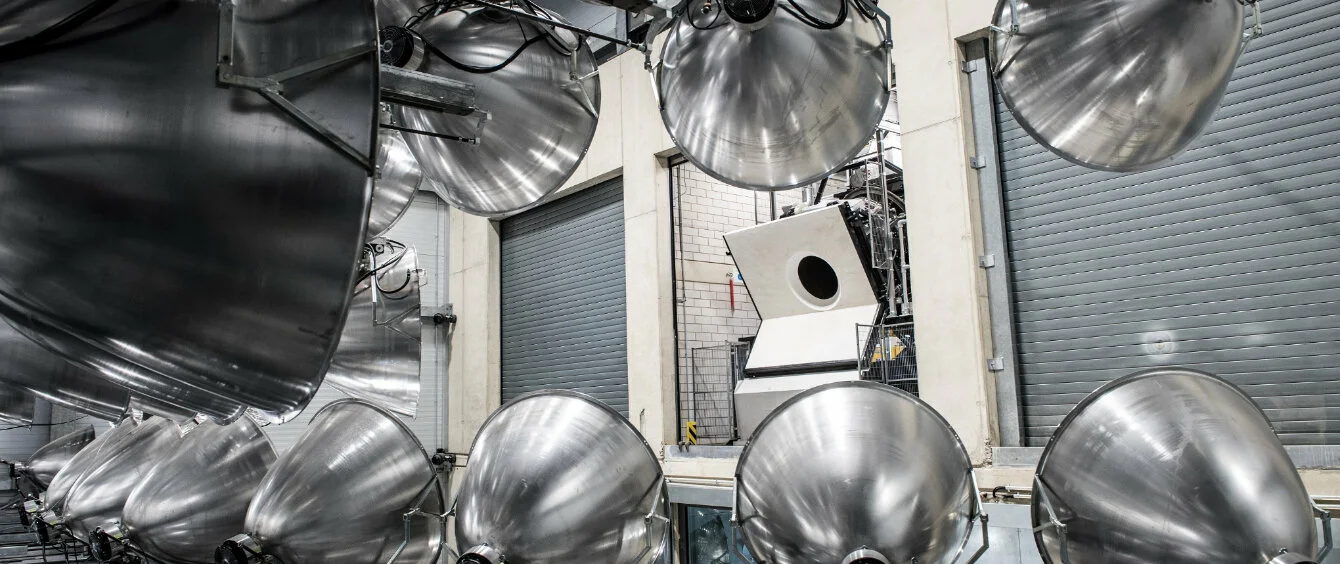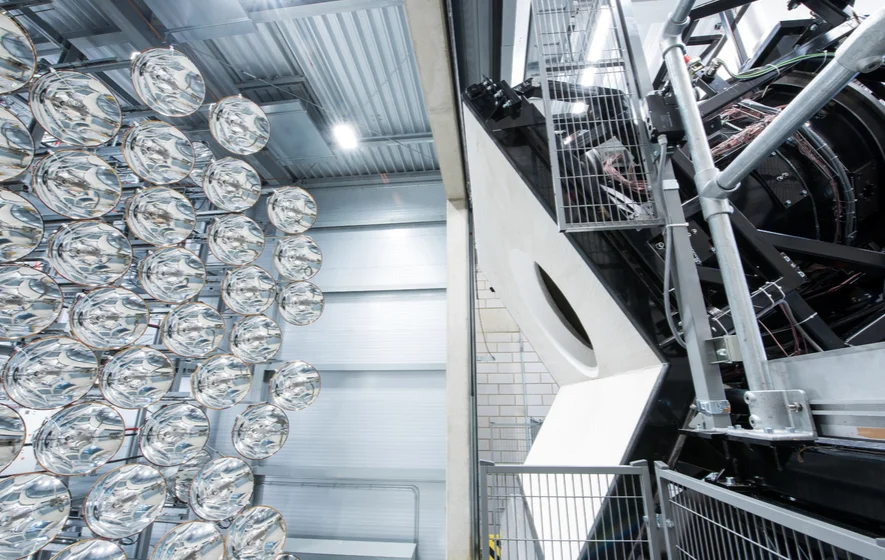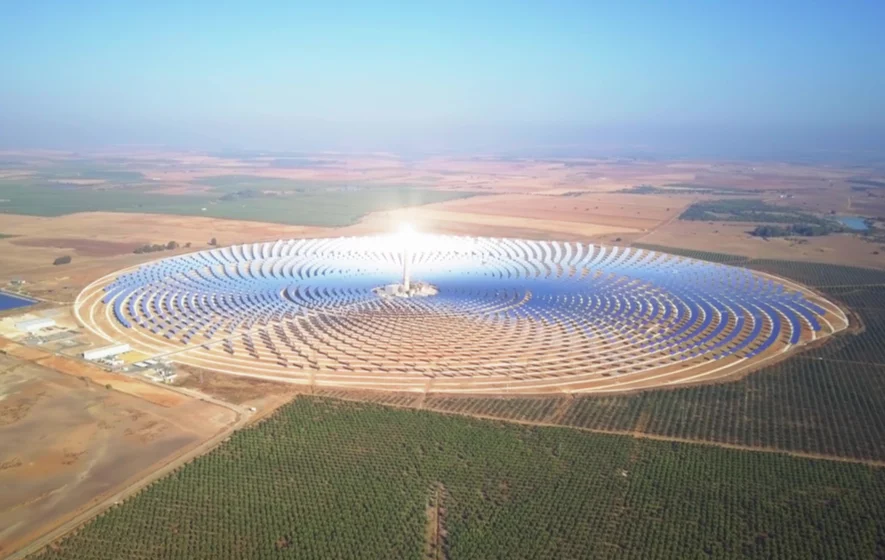In the PEGASUS research project, the German Aerospace Center’s Institute of Solar Research in Jülich is studying a completely new kind of solar thermal power plant which stores solar energy in sulphur. This technology operates as a self-contained cycle, but its real advantage lies elsewhere: it not only generates electricity without any greenhouse gas emissions, it could also help decarbonise parts of the chemicals industry and agriculture. Project coordinator Dennis Thomey explains how this works in en:former.
Mr Thomey, when we are reporting on power-to-x technologies in en:former, we can generally get by without too much detailed knowledge of chemistry. Today, we are talking about a thermochemical sulphuric acid power plant that your project has been working on. How much chemistry do we need for this?
It’s really the combination of physics and chemistry that makes the PEGASUS project so demanding. But I think that most of this technology’s advantages and disadvantages can be explained without going too deep into the science.
OK. Let’s start with one component, the solar receiver. Can you explain what that is?
The solar receiver collects concentrated solar radiation and transforms the light into heat, which is then transferred to a heat storage medium for further use. A typical application is in concentrated solar power (CSP) plants, where the solar receiver is located in a tower. Several thousand mirrors, called heliostats, positioned on the ground around the tower focus the sunlight on the receiver.
In traditional CSP plants, molten salt is currently used as a heat storage medium. Using the heat, steam is produced to drive a turbine, which then produces electricity via a generator.
So, the solar receiver is a part of the system that harnesses the heat of the sun. This also applies in the PEGASUS plant. But traditional receivers are not adequate. You have developed a solar receiver that uses a different heat storage medium at the DLR’s Institute of Solar Research in Jülich.
That’s correct. We are using ceramic particles with a diameter of about one millimetre, which are heated in a so-called centrifugal particle receiver. We developed this technology in Jülich and have further refined it as part of the PEGASUS project. Using the so-called CentRec® technology, the particles are fed into a rotating chamber and pressed against its interior surface by the centrifugal forces, where they form a particle film about three millimetres thick, which is heated by the concentrated solar radiation.
Compared to molten salt, the bauxite particles are easier to handle: they pose no health hazards and are not corrosive, so they can simply be stored in insulated containers. However, they reach significantly higher temperatures of around 900 degrees Celsius, instead of 550 degrees. This is necessary to thermally decompose the sulphuric acid in an innovative reactor that we developed in the PEGASUS project.
And this is where the chemistry starts…
The energy from the ceramic particles heats a reactor, which splits the sulphuric acid in several steps. Another step, the so-called disproportionation reaction, yields pure sulphur. The other two by-products are oxygen and water.
In order to recover the stored thermal energy, the sulphur can then be combusted in a conventional plant and converted back into sulphuric acid. The surplus heat from such plants has already been used for electricity generation for many decades.
But in the PEGASUS project, we have developed a new kind of sulphur burner, which operates at higher pressures and is thus suited for use in highly efficient gas and steam turbine power plants.
Anyone familiar with power-to-x technologies knows that there are transformation losses in chemical reactions. However, the energy expended is worth it in applications such as those in the transportation sector, which require the energy density of the fuel. How is sulphur as a medium for energy?
When we say that a monocrystalline PV panel has an efficiency of 22 percent, then we are talking about ideal sunlight conditions, without clouds. But photovoltaic systems only use certain frequencies of solar radiation and can only be operated on sunny days. By contrast, solar thermal plants use the entire spectrum and store the heat for operations when there is no sunlight. The electrical efficiency of our sulphuric acid power plant reaches almost ten percent.
Nevertheless, PEGASUS still falls short of existing CSP plants, which have electrical efficiency levels between 15 and 20 percent. What is the advantage of a sulphuric acid power plant?
Traditional CSP power plants can store energy during the day and generate electricity at night. This makes them ideal for complementing photovoltaic generation, which can only produce electricity during the day. Sulphuric acid power plants can also function as seasonal energy storage solutions. According to our calculations, a PEGASUS system in a sunny area such as the Sahara could operate 50 to 51 weeks annually. In theory, it could run 365 days a year, but that would not be economical, because the storage facilities would have to be very large.
Unless the sulphur produced was exported. That’s another advantage. It’s not so easy to send electricity from the Sahara to Germany. But pure sulphur can be shipped easily and stored outdoors in piles until it is used.
And this is sufficient to offset the disadvantage in efficiency?
No. But our process is really about the sulphuric acid. No other chemical in the world is produced in such large quantities as sulphuric acid. It is used mainly in fertilizer production, but also in other parts of the chemicals industry.
So far, sulphuric acid has been produced almost exclusively using crude oil. During use, for example in fertilizer production, it becomes contaminated and has to be processed again before being used again. Generally, however, it is simply disposed of, because refineries can produce enough cheap sulphuric acid.
But if less and less petroleum is used and processed in the coming years, the need for recycled sulphuric acid will automatically increase. And that’s where we fit in: our sulphuric acid reactor can also split contaminated sulphuric acid. Following electricity generation, we get pure sulphuric acid again. So, the whole PEGASUS is not only a power plant: it’s also a recycling plant for sulphuric acid.
Do you think your customer base is not really in electricity production, but rather in the chemicals industry?
The sulphuric acid industry has to be the driving force behind our technology. Cheaper technologies are available for pure electricity generation. But much of the low-hanging fruit in the energy transition has already been harvested: it’s easy to ensure supply with a share of 50 percent wind and photovoltaic, but it gets more difficult above that. CSP plants have no chance in Central Europe, and additional hydroelectric capacity is also limited. So, for the next 50 percent, we need storage and carbon-free power plants that operate more independently of the weather.
But more importantly, the struggle against climate change is not only about the energy transition, and the energy transition itself involves more than just sustainable electricity generation. In order to meet the climate goals, other sectors such as steel and cement producers, as well as the chemicals industry and agriculture, have to cut their emissions. So, eventually sulphuric acid will also have to be produced without generating emissions.
Six institutes and companies from five countries participated in the PEGASUS project.
German Aerospace Center (DLR) Institute of Solar Research
Karlsruhe Institute of Technology (KIT) Engler-Bunte-Institute
Will the mounting demand for sulphuric acid recycling be enough to make the PEGASUS technology profitable? Or do you also need a higher CO2 price?
Demand alone won’t be enough, because there are cheaper alternatives. It’s actually the CO2 price that is critical. According to our calculations, the price would have to be around 150 euros per tonne of CO2 for a solar sulphuric acid power plant to be profitable.
CO2 prices in the European EU ETS system recently surged higher and ranged at 60 euros around the end of September. So you apparently still have some time to optimise this technology. When do you think that PEGASUS will be ready for the market and vice-versa?
It’s true that we still have work to do in developing this technology. For instance, we have to actually build the reactors that we need at an industrial scale. We believe that it will be 10 to 15 years before the first real solar sulphuric acid power plant is built.




